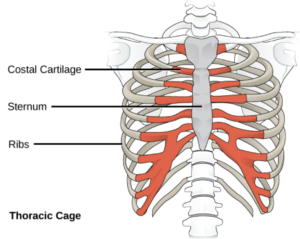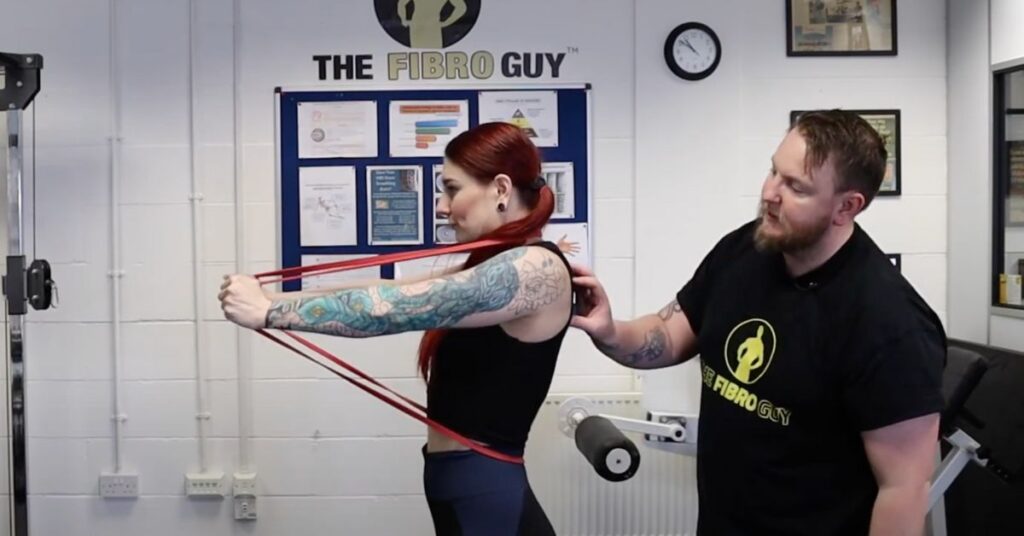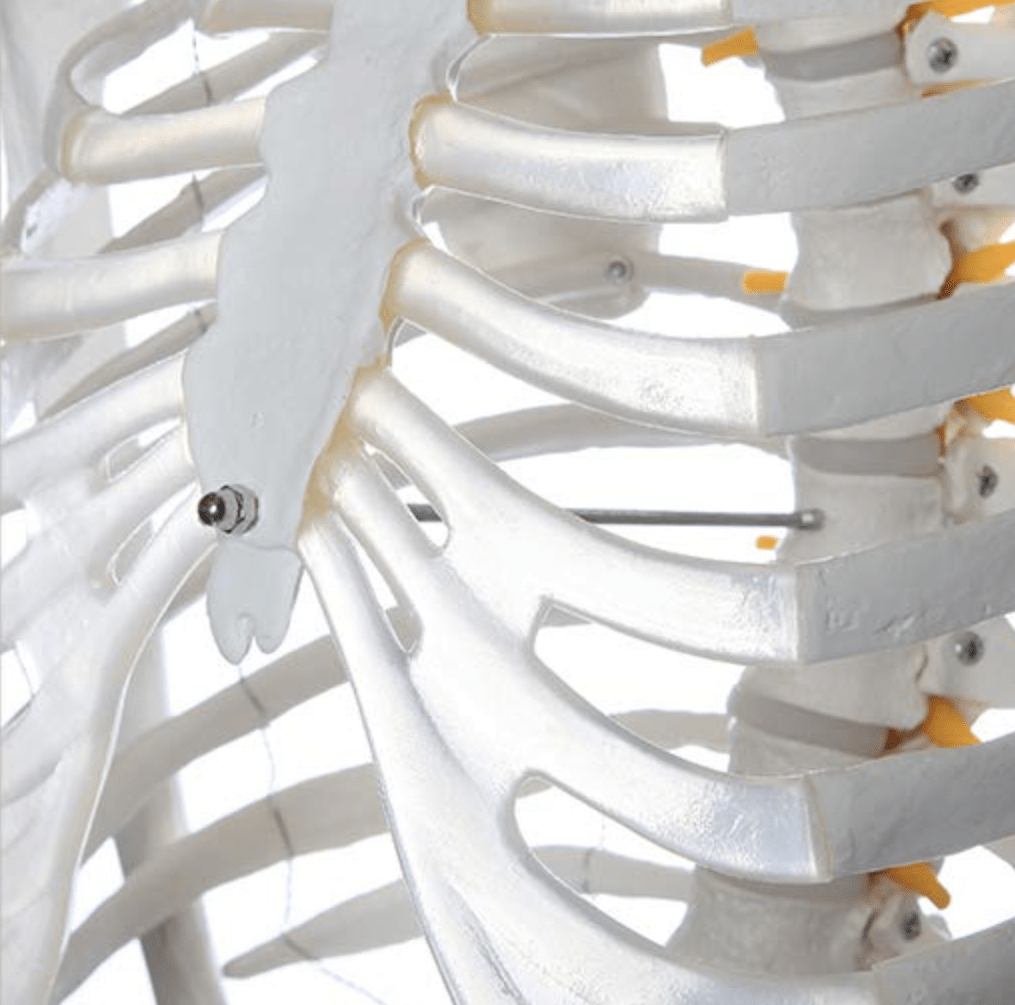- Exercise Tips for Hypermobility - 24 July 2024
- Creatine Benefits for Hypermobility and EDS - 21 July 2024
- Low-Dose Naltrexone For Fibromyalgia - 29 May 2024
If you would prefer to listen to this article, then please click below.
Let’s talk about the dreaded hypermobility rib subluxation and the current subluxation exercises that are out there. It’s no secret that subluxations and dislocations are more prevalent in the hypermobile population, which means an unfortunate victim of subluxations can be the ribs. Subluxation of the ribs can make us feel like we’ve been shot, instantly stopping us in our tracks, and making us incredibly fearful of any future movement. Whilst producing pain to halt any further injury or damage makes complete sense, it does cause problems further down the line. The more we guard our movement because of the pain of subluxation, the more we actually increase the risk of them reoccurring.
With Hypermobility, a lot of emphasis is placed on stability, and whilst this is important, it is only one small piece of a much larger picture. Most of the hypermobility rehab we have seen regarding the ribs seems to focus on non-transferable exercises. Much like if you asked me to teach you piano, but I asked you to practice on a guitar. These are both essentially music, but they are very different. The same is true for hypermobility rib subluxation exercises. You are practising on a guitar to learn the piano.
It’s important to understand that stability comes more from the neurological system, than it ever does from the musculoskeletal system. This is essential when it comes to correct hypermobility rehab, and in our case with this article, hypermobility rib subluxation exercises.
This article covers:
ToggleThe Ribs
The various sections of our ribs come with slightly different amounts of inherent stability, as not all ribs connect to an anchor point:

True ribs, which are defined as ribs 1-7, connect to the sternum or what is also commonly referred to as the breast bone. These ribs hold the most stability as they are anchored by thoracic vertebrae and sternum attachments.
False ribs, which are defined as ribs 8-10, indirectly connect to the sternum via their attachment to the costal cartilage of the sternum.
Floating ribs, which are defined as ribs 11 and 12, only connect to the thoracic spine and float at the front of the rib cage, hence their name “floating ribs”.
The rib cage needs to offset some degree of stability in order to gain much-needed mobility. A little like your shoulders. By using the attachments to cartilage and tendons, the ribs can move to accommodate the lungs’ expanding. However, because collagen makes up 2/3rds of cartilage, and collagen is the protein affected in conditions such as EDS, these ribs will be slightly less stable than they inherently should be.
Issues that come with hypermobile rib subluxations
We mentioned early on that other issues come with hypermobility rib subluxation, and a few we find in our new Hypermobile clients are:
Movement Anxiety and Thoracic stiffness
Being anxious about movement after a rib subluxation is incredibly common, and more importantly, it is a very understandable reaction. Humans will do almost anything to avoid the threat of pain, and rib subluxations are no different. One of the reasons that pain serves as such an effective protection mechanism is that it’s such a horrible experience we will always try to avoid it.
The problem we face though is that as we become more fearful of movement, we tend to enact various guarding mechanisms to try and protect ourselves, whilst also creating a sense of stability. Whilst this may seem like a good idea in the short term, it causes a myriad of problems later on down the line.
Those in pain can enter into what is referred to as a mechanically coupled guarding response. This is where the pelvis and thorax couple and lock together to slow the rotation of the trunk. This means that more stiffness is created in the trunk, leading to stiffer tissues and less room for movement. For those with hypermobility, stiffness is not their friend, as when guarding, it allows muscles to connect and create greater pull forces, which ligaments and cartilage don’t deal with very well in those with hypermobility. As such, with a stiff trunk and hypermobility of ribs, it can easily cause issues as the rib tip slips under the rib above, causing impingement of the intercostal nerve passing along the undersurface of the adjacent rib.
Whilst adopting protective postures, those with a hypermobility rib subluxation will also find that they will walk at a slower pace as they lack the counter-rotation of the ribs and hips when moving to create an easier gait. Think of the differences people experience when they go for a brisk walk compared to a slow walk around a museum, the latter is far more tiring and that’s because of the lack of efficiency when we don’t counter-rotate during our gait cycle.
Another issue we commonly find in our hypermobile clients is that of thoracic stiffness. As we have already mentioned above, adopting guarding postures to prevent pain can cause individuals to essentially lock up. This is true also for the thoracic spine, as ribs are connected to the spine, and we often find that individuals will avoid simple movements like flexion and extension to avoid moving their ribs, likewise, they often adopt shallow breathing patterns. However, the spine, much like ribs, is meant to move, it’s meant to rotate, bend, and hydrate tissue. When individuals lock down and stop moving, it can lead to hypoxic and inflammatory conditions which can easily become an initiating factor for more stiffness and pain.
Sleep Disturbances
If the last few decades of research into sleep and pain have taught us anything, it’s that with lack of sleep comes a prevalence for more pain. Sleep disruptions lead to hyperalgesia pain changes, which means that your brain becomes far more responsive to noxious stimuli, lowering the pain threshold, and even going as far as impacting our own bodies’ ability to realise pain-killing chemicals. If you are dealing with a rib subluxation, then sleeping is going to become an arduous task, and can easily lead to more pain. After all, sleep is a natural analgesic that can help to manage and lower pain, and a hypermobility rib subluxation is going to interfere with sleep!
Costochondritis
Costochondritis is chest wall pain caused by inflammation of the costal cartilage or the area where the ribs meet the sternum, known as sternal articulations. It can cause chest pain that can range from mild to severe, and even mimic the feeling of heart problems, which can be not only incredibly frightening but can create more fear around moving. Going back to trunk stiffness for a moment, we can see the rigidity of the ribs whilst still moving, has the potential to pull on the cartilage causing inflammation and a recurrence of hypermobility rib subluxation. Ribs are meant to move, and when we deviate from how they are designed, you can see we have a whole host of potential problems just around the corner.
The best exercises for hypermobility rib subluxations
Prevention is always better than cure when it comes to rib subluxations, which means it’s far easier to focus on preventive measures than trying to recover from a subluxation or slip. We have had fantastic results in the studio helping clients to stabilise their ribs with some of our trialled and tested “Hypermobility Mapping” techniques. However, without seeing people in the studio, it’s fairly hard to teach. But that doesn’t mean you can’t help yourself.
Let’s cover two basic principles that you at home should be focusing on when it comes to rib subluxation exercises: Simple Mapping and Mobility.
- Simple Mapping: If your brain doesn’t know where your joints are, it can’t stabilise and coordinate your movements, resulting in extra pull forces acting on cartilage and ligaments.
- Mobility: If your body is restricted from pain-guarding behaviours, then the ribs angle downwards, the rib cage compresses, and our rate of subluxation increases.
For many of you, mapping, will be a completely new concept that may blow away the current understanding of subluxations, not just in the ribs but all the joints.
In fact, I would recommend the article Hypermobility and Exercise: Part 1, as this article goes into cortical mapping fairly deep.
Hypermobility rib subluxations are caused when pull forces are enacted on the rib cage, which you neither have the mobility nor stability to handle. Most rib subluxations occur during lapses of concentration. Such as reaching around the television set to turn it off at night, or when you are standing talking on the phone, etc. It’s far more difficult to sublux or dislocate when you are actively thinking and moving a joint. However, movement is autonomous, it’s supposed to happen by itself without much conscious thought.
The current rib subluxation exercises
You will have noticed that many of the rib subluxations exercise out there consist of gentle breathing exercises or thoracic mobility. However, there is a downfall to following these types of exercises: they don’t address the main issue which is mapping. More importantly, they are not transferable to everyday life. Meaning that once you finish them and go about your day… “Pop” there goes your rib again. Cortical mapping is one of the areas that we focus on with our hypermobile clients. This has resulted in our client’s results being unmatched worldwide. After we have spent more than 10 years researching and perfecting our mapping techniques.
Whilst Cortical mapping warrants a whole blog post unto itself, I won’t dive too deep here. Mapping can be long and complicated, and it’s something we have to spend a long time covering with our clients. Most of the people we see, seem to be stuck in the old strength and stability mindset for hypermobility rehab. And whilst strength and stability are somewhat important, they are not the most important aspect of hypermobility rehab, not by a long shot.
In a nutshell: Cortical mapping is the communication between your motor cortex & sensory cortex. If they aren’t singing from the same song sheet your brain and body don’t know where they are in space & time. This disconnect between movement intention and action makes you far more likely to sublux.
When it comes to rib subluxation exercises, people sing the praises of proprioception a great deal. However, proprioception is the effect of cortical mapping, not the cause of it. You already have enough muscle mass right now to be able to support your joints. The problem is that it isn’t recruited appropriately by the motor cortex which leaves joints feeling loose & floppy. Throw lax connective tissue into the mix and it’s a perfect recipe for dislocations and subluxations.
How is mapping relevant to hypermobility rib subluxations?
Because when your brain knows where your joints are when your body is relaxed, it can react quickly to movement through predictions and keep your joints in place. This means you keep your mobility alongside stability. Whilst your ribs don’t absorb any extra force that can displace your ribs. However, this stability in softness is not a conscious action, and this is why many so-called proprioception exercises don’t yield many benefits.
The first step to preventing a hypermobility rib subluxation is to get them mapped! Allowing your brain to know where your ribs are located, gives you unconscious stability, because your brain knows exactly how much movement they have, and it is this that is important. People rarely sublux when they are focused on a joint, they sublux during moments of thought and lapses of concentration. This is why slow-moving and conscious exercise doesn’t stabilise joints because most of them are not transferable to how we actually spend our days. Mapping the ribs can be a challenge and our clients are so cautious of slipping a rib that they will be flat-out frightened to move. Mobility and mapping are some of the keys to getting your ribs to stay in place!
During our hypermobility rehab programmes, our clients increase their mapping in all of their joints. Once the dislocations cease, then we start to build muscle tone and they go on to do everything they have always wanted, but It all starts with mapping their joints! Whilst this is hard to perform without 1:1 instruction, we have recorded a short YouTube clip to help you with some of the very basic mapping points and rib subluxation exercises to help you start to get on top of your rib subluxations.
We hope you enjoy it and please let us know how you get on in the comments.
——The Fibro Guy Team——
Looking for more articles?
What is the best diet for hypermobility?
Running with hypermobility
Hypermobility Jaw Pain: TMJD Exercises






